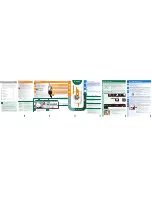
5
2. Place the nozzle approximately 4-5
feet from and 45 degrees to the
cleaning surface, and trigger the gun.
3. Vary the fan pattern spray angle and
the distance to the cleaning surface
until optimum cleaning efficiency is
achieved without damaging the sur-
face.
TURBO NOZZLE (NOT INCLUDED WITH
ALL MODELS)
A turbo nozzle, sometimes referred to as
a rotary nozzle, can be a very effective
tool that can significantly reduce cleaning
time. The turbo nozzle combines the
power of cleaning with a narrow high
impact stream with the efficiency of
cleaning with a 25 degree fan pattern.
This is accomplished by swirling a narrow
high impact stream into a cone shape
that cleans a larger area.
Caution
: Since
a turbo nozzle uses a narrow high impact
stream, only use a turbo lance in applica-
tions where the cleaning surface cannot
be damaged by narrow high impact
spray. Additionally, the Turbo Nozzle is
NOT adjustable and cannot be used to
apply detergent.
DETERGENTS
The use of detergents can dramatically
reduce cleaning time and assist in the
removal of difficult stains. Many deter-
gents have been customized for pressure
washer use on specific cleaning tasks.
These detergents are approximately as
thick as water. The use of thicker deter-
gents, such as dish soap, will clog the
chemical injection system and prevent the
application of the detergent.
The cleaning power of detergents comes
from applying them to a surface and giv-
ing the chemicals time to break down the
dirt and grime. Detergents work best
when applied at low pressure.
The combination of chemical action and
high pressure rinsing is very effective. On
vertical surfaces, apply the detergent
starting at the bottom and working your
way upward. This will prevent the deter-
gent from sliding down and causing
streaks. High pressure rinsing should also
progress from the bottom to top. On
particularly tough stains, it may be neces-
sary to use a brush in combination with
detergents and high pressure rinsing.
The following cleaning procedure will
help you to organize your cleaning task,
and ensure that you achieve the most
beneficial results in the shortest amount
of time. Remember to use the
spraying/cleaning techniques previously
listed.
Before starting a pressure washer clean-
ing job, it is important to prepare the
surface that is to be cleaned. This is
done by clearing the area of furniture,
and making sure that all windows and
doors are closed tight. In addition, you
should make sure that all plants and
trees adjacent to the cleaning area are
protected by a drop cloth. This will
ensure that your plants won’t be sprayed
by the detergents.
The next step is to spray the cleaning sur-
face with water to clear off any dirt or
grime that may have collected on the
surface. This will allow your detergent to
attack the deep down dirt that has
worked its way into the cleaning surface.
Before triggering the gun, adjust the
nozzle to a wide fan pattern and slowly
adjust to the desired spray pattern. This
will help you avoid applying too much
concentrated spray to the surface which
could cause damage.
USE THE INSTRUCTIONS APPROPRIATE
FOR MODEL PURCHASED
NOTE
: Use only detergents formulated
for pressure washers.
NOTE
: Test detergent in an inconspicuous
area before use.
FOR MODELS WITHOUT
DETERGENT TANK
1. Unscrew the top of the
detergent applicator
and fill container with
undiluted detergent.
Pre-Operation (Continued)
3. Detergent Application
2. Replace the top to the applicator.
3. Remove the lance from the gun.
4. Attach the detergent applicator to
the gun as pictured in Figure 7.
5. Apply the detergent so that it thor-
oughly covers the cleaning surface.
Apply from bottom to top to prevent
the detergent from sliding down and
streaking.
6. Allow the detergent to remain on the
surface for a few minutes. This is a
good time to use a brush to lightly
scrub heavily soiled areas. Never
allow the detergent to dry on the
cleaning surface.
7. Remove the detergent applicator
from the gun and replace with the
lance.
8. Rinse detergent from surface.
Note
: Flush the detergent applicator with
clear water following each use.
Operation
Figure 6 - Detergent application
1. Surface Preparation
2. Initial High Pressure Rinse
www.campbellhausfeld.com
Electric Units with Detergent
Applicator (Included)
Detergent
Applicator
Figure 7


























